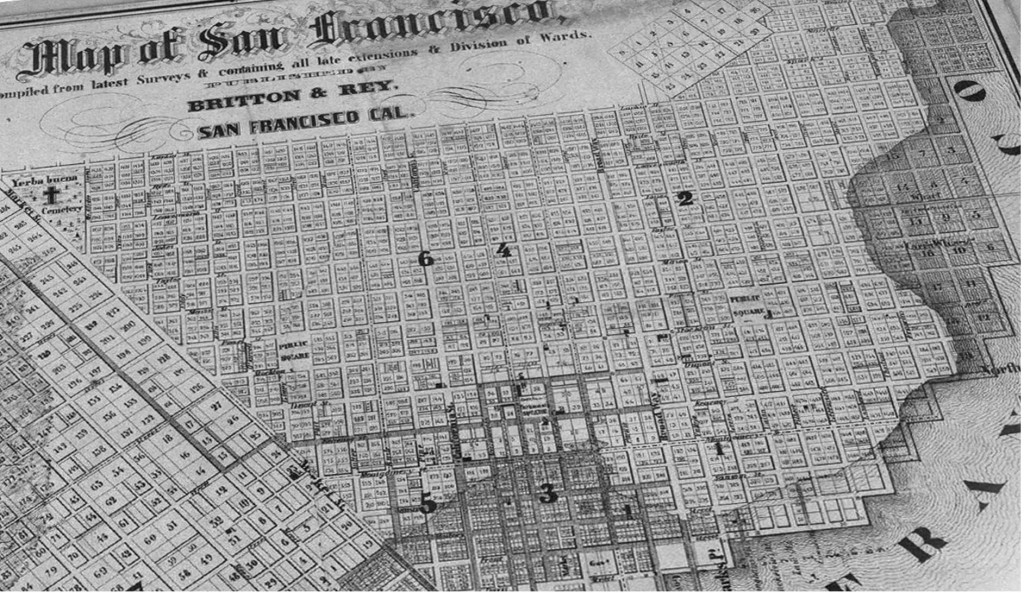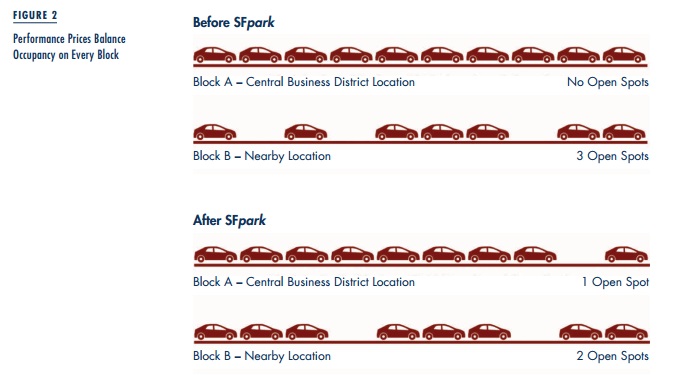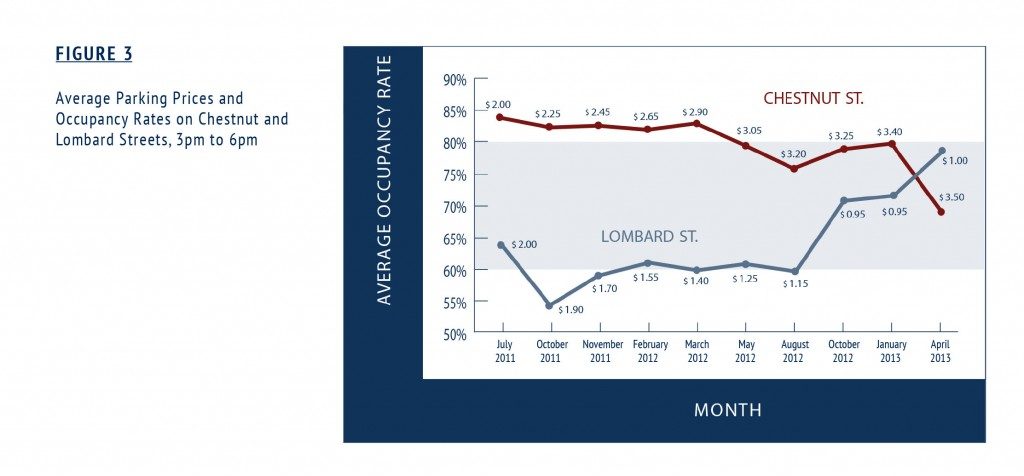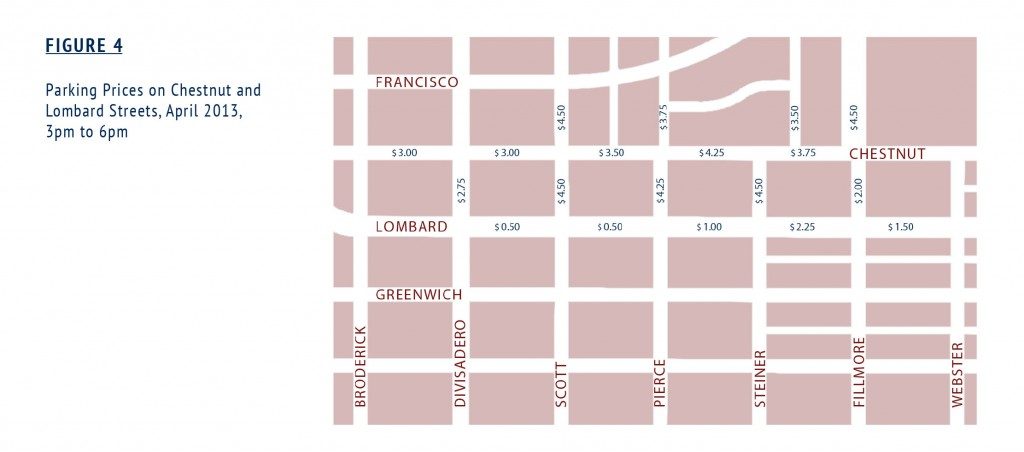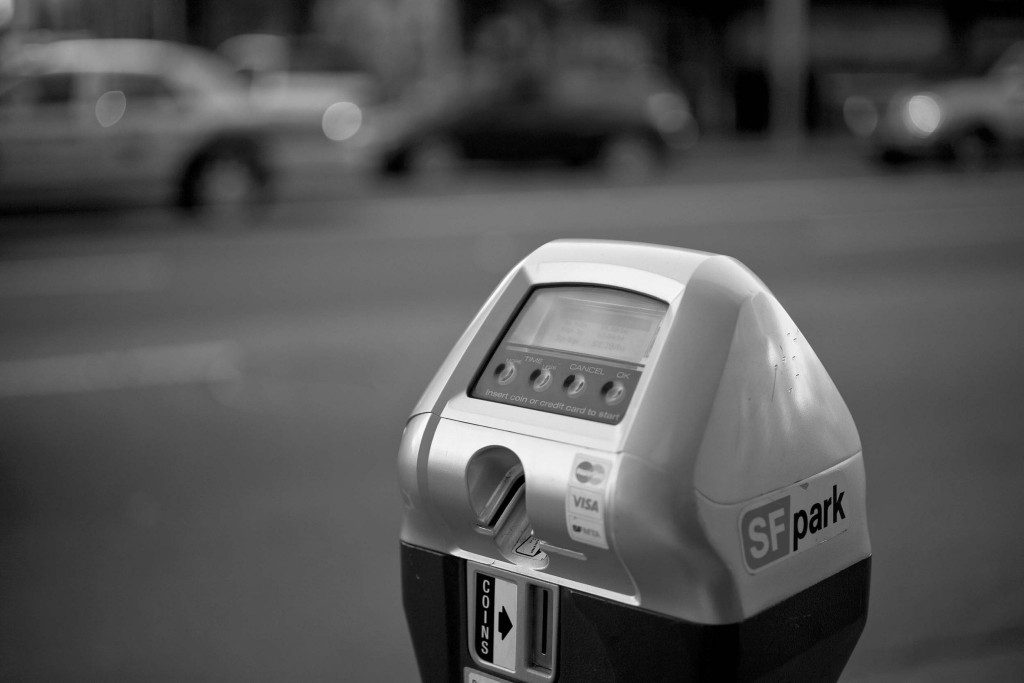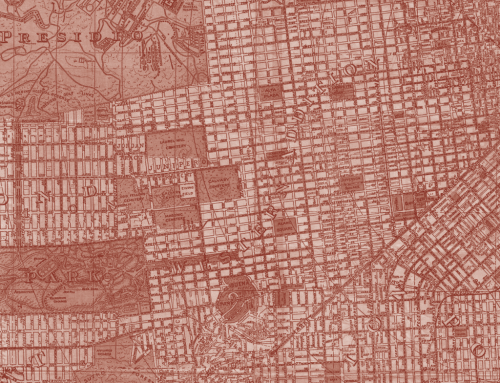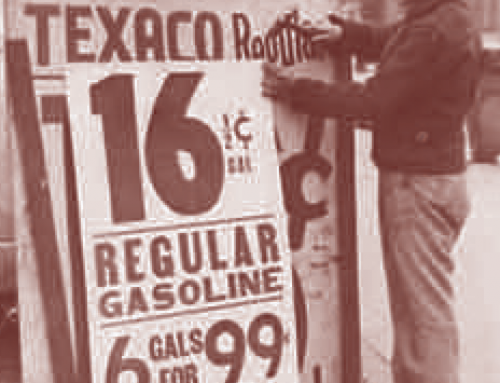In 2011, San Francisco adopted the biggest price reform for on-street parking since the invention of the parking meter in 1935. Most cities’ parking meters charge the same price all day, and some cities charge the same price everywhere. San Francisco’s meters, however, now vary the price of curb parking by location and time of day.
SFpark, San Francisco’s new pricing program, aims to solve the problems created by charging too much or too little for curb parking.
SFpark, San Francisco’s new pricing program, aims to solve the problems created by charging too much or too little for curb parking. If the price is too high and many curb spaces remain open, nearby stores lose customers, employees lose jobs, and governments lose tax revenue. If the price is too low and no curb spaces are open, drivers who cruise to find an open space waste time and fuel, congest traffic, and pollute the air.
In seven pilot zones, San Francisco installed sensors that report the occupancy of each curb space on every block, and parking meters that charge variable prices according to the time of day. In response to the observed occupancy rates, the city adjusts parking prices about every two months.
Consider the prices of curb parking on a weekday at Fisherman’s Wharf, a tourist and retail destination [Figure 1]. 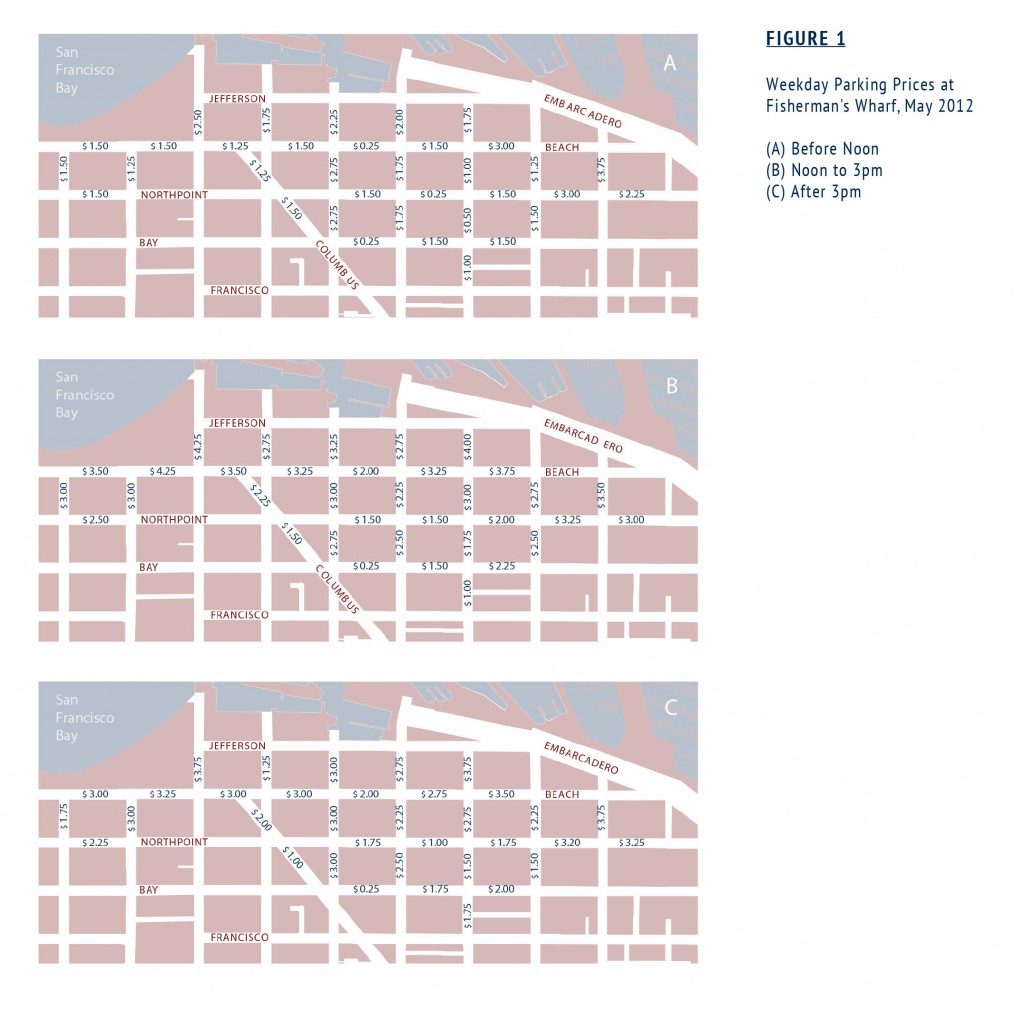 Before SFpark began in August 2011, the price was $3 an hour at all times. Now each block has different prices during three periods of the day—before noon, from noon to 3 pm, and after 3 pm. By May 2012, prices on almost every block had decreased for the period before noon and increased between noon and 3 pm. Most prices after 3 pm were lower than during mid-day, but higher than in the morning.
Before SFpark began in August 2011, the price was $3 an hour at all times. Now each block has different prices during three periods of the day—before noon, from noon to 3 pm, and after 3 pm. By May 2012, prices on almost every block had decreased for the period before noon and increased between noon and 3 pm. Most prices after 3 pm were lower than during mid-day, but higher than in the morning.
SFpark bases these price adjustments purely on observed occupancy. Planners cannot reliably predict the right price for parking on every block at every time of day, but they can use a simple trial-and-error process to adjust prices in response to occupancy rates. This process of adjusting prices based on occupancy is often called performance pricing. Figure 2 illustrates how nudging prices up on crowded Block A and down on under-occupied Block B can shift a single car to improve the performance of both blocks.
Beyond managing the on-street supply, SFpark helps to depoliticize parking by setting a clear pricing policy. San Francisco charges the lowest prices possible without creating a parking shortage. Transparent, data-based pricing rules can bypass the usual politics of parking. Because demand dictates the prices, politicians cannot simply raise them to gain more revenue.
Did SFpark Move Parking Occupancy in the Right Direction?
After several years of planning, the San Francisco Municipal Transportation Authority (SFMTA) launched SFpark in April 2011 by installing new parking meters and extending or removing the time limits on curb spaces. The pilot program covers seven zones that contain 7,000 metered curb spaces. The initial prices in each zone were simply carried over from the previous, uniform pricing scheme. Under the new SFpark program, most meters operate daily from 9 am to 6 pm, with prices that vary by the time of day and between weekdays and weekends. SFMTA established the desired target occupancy rate at between 60 and 80 percent for each block. If the average occupancy on a block for a given period falls in this range, the price will not change in the following period. San Francisco’s pricing policy is thus data-driven and transparent, while most other cities’ pricing policies are political and opaque.
SFpark has two goals: to make curb parking readily available, and to ensure that curb parking accommodates as many customers as possible for the adjacent businesses.
In setting a target occupancy rate, SFpark has two goals: to make curb parking readily available, and to ensure that curb parking accommodates as many customers as possible for the adjacent businesses. These two goals conflict because when meter rates increase to encourage one or two open spots per block, the higher prices also reduce average occupancy.
 For example, large groups gathering at a restaurant may generate exceptionally high parking demand on a block on some days, so cities cannot aim for a consistently high occupancy rate of 80 to 90 percent without often reaching 100 percent occupancy, which produces unwanted cruising. A lower average occupancy, however, means fewer customers. San Francisco set the target occupancy rate at between 60 and 80 percent to cope with the random variation in parking demand and to balance the competing goals of reliable availability and high occupancy. If SFpark works as intended, prices will move occupancy rates toward this target range.
For example, large groups gathering at a restaurant may generate exceptionally high parking demand on a block on some days, so cities cannot aim for a consistently high occupancy rate of 80 to 90 percent without often reaching 100 percent occupancy, which produces unwanted cruising. A lower average occupancy, however, means fewer customers. San Francisco set the target occupancy rate at between 60 and 80 percent to cope with the random variation in parking demand and to balance the competing goals of reliable availability and high occupancy. If SFpark works as intended, prices will move occupancy rates toward this target range.
During its first two years, SFparkadjusted prices 11 times on each block for three different periods during the day. Prices increased in 31 percent of the cases, declined in 30 percent, and remained the same in 39 percent. On average, prices declined in the morning and increased in the midday and afternoon. The average price fell 4 percent, which means SFpark adjusted prices up and down according to demand without increasing prices overall.
Because occupancy rates have moved toward the target goals, the share of blocks needing no price adjustment has slowly increased since the program began. By August 2013, after the program had been operating for two years, 62 percent of blocks were in the target range. Altogether, a third of all the blocks that had been over- or under-occupied at the beginning of SFpark had shifted into the target occupancy range.
We can use an example of parking prices and occupancy rates on Chestnut and Lombard Streets in the Marina District to show the effects of SFpark. In July 2011, these parallel streets had the same meter rate ($2 an hour) but very different occupancy rates. All five blocks of Chestnut were over-occupied (above 80 percent); of the five blocks on Lombard, two were under-occupied (below 60 percent), and three were in the target range (60 to 80 percent). What would it take to shift a few cars from the over-occupied blocks on Chestnut to the under-occupied blocks on Lombard?
Figure 3 shows the path of average prices and occupancy on the five blocks of Chestnut and Lombard Streets from 3 pm until 6 pm. In response to the over- and under-occupancy, SFpark began to increase the prices on Chestnut and reduce them on Lombard. After 10 price changes in two years, the average price on Chestnut had climbed by 75 percent to $3.50 an hour; on Lombard it had fallen by 50 percent to $1.00 an hour. As prices diverged, occupancy rates converged within the target range.
Figure 4 shows the parking prices on each block in April 2013. Between Pierce and Scott Streets, for example, the price on Chestnut was $3.50 an hour, and just a block away the price on Lombard was only 50 cents an hour, yet both blocks were in the target occupancy range. Parking spaces so close together would seem close substitutes for each other, but the huge price differences reflect very different local demand patterns.
Price Elasticity of Demand
Before each price change, SFpark publishes data on the occupancy and prices for all curb spaces in the pilot zones. The price elasticity of demand measures how these price changes affected occupancy rates. Economists define price elasticity as the percent change in the occupancy rate (the quantity of parking demanded) divided by the percent change in the meter price. For example, if a 10 percent price increase leads to a 5 percent fall in occupancy, the price elasticity of demand is –0.5 (–5% ÷ 10%).
We calculated the elasticity of demand revealed by all the price changes during SFpark’s first year. For each price change, we compared the old price and average occupancy to the new price and average occupancy during the following period. We thus have 5,294 elasticity measurements, one for each price change during the year at each time of day at each location.
The average price elasticity of demand was −0.4, but when we plot the elasticity for individual price changes at the block level, we find astonishing variety. Figure 5 shows the distribution of the price elasticities calculated for 5,294 individual price and occupancy changes on 1,492 city blocks.
Higher prices should reduce occupancy, and lower prices should increase occupancy. In many cases, however, occupancy either rose after prices rose or fell after prices fell.
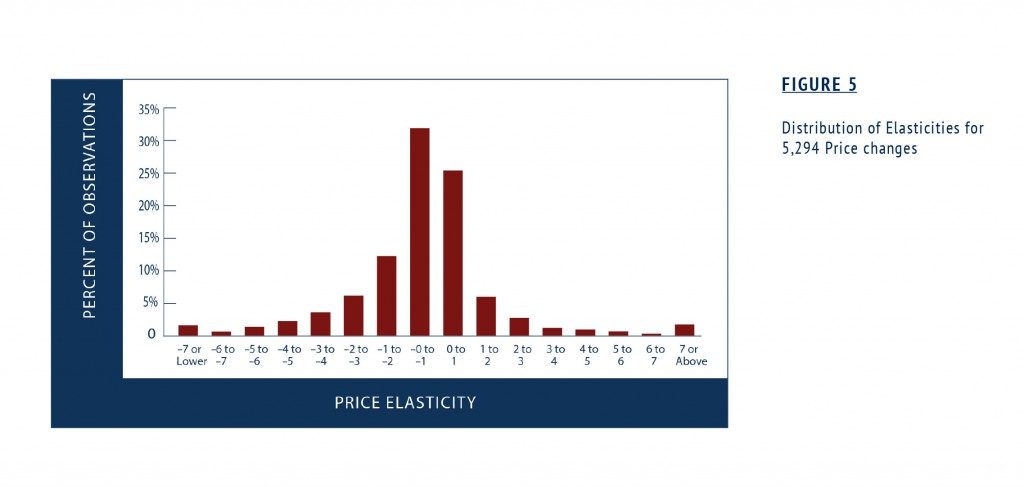 The wide range of price elasticities suggests that many variables other than price affect parking demand. Higher prices should reduce occupancy, and lower prices should increase occupancy. In many cases, however, occupancy either rose after prices rose or fell after prices fell. Higher prices do not cause higher occupancy, and lower prices do not cause lower occupancy, so other factors must have overwhelmed the effects of prices on occupancy in the cases of positive price elasticity.
The wide range of price elasticities suggests that many variables other than price affect parking demand. Higher prices should reduce occupancy, and lower prices should increase occupancy. In many cases, however, occupancy either rose after prices rose or fell after prices fell. Higher prices do not cause higher occupancy, and lower prices do not cause lower occupancy, so other factors must have overwhelmed the effects of prices on occupancy in the cases of positive price elasticity.
The wide range of elasticity at the block level also suggests that the circumstances on individual blocks vary so greatly that planners will never be able to estimate an accurate elasticity to predict the prices needed to achieve the target occupancy for every block. Instead, the best way to achieve target occupancy is to do what SFpark does: adjust prices in response to the observed occupancy. This trial-and-error method mirrors how other markets establish prices, so it should work in the market for on-street parking.
Equity in Performance Pricing
While it is clear that performance parking prices can improve transportation efficiency, are they fair? In San Francisco, 30 percent of households do not own a car, so they don’t pay anything for curb parking. How the city spends its parking revenue also affects the equity implications of charging for parking. San Francisco uses all its parking meter revenue to subsidize public transit, so automobile owners subsidize transit riders. SFpark will further aid bus riders by reducing traffic caused by drivers cruising for underpriced curb parking.
Performance pricing is not price discrimination because all drivers who park on the same block at the same time pay the same price. Performance pricing is also not the same as maximizing revenue. Because demand was, on average, inelastic, the city could increase revenue by charging higher prices. However, SFpark’s goal is to optimize occupancy, not to maximize revenue, and the average price of parking fell by 4 percent during SFpark’s first two years.
SFpark’s goal is to optimize occupancy, not to maximize revenue, and the average price of parking fell by 4 percent during SFpark’s first two years.
Three Suggested Improvements
Our findings suggest three ways to improve SFpark: (1) refine the periods of operation, (2) shift from reaction to prediction in setting prices, and (3) end the abuse of disabled placards.
Refine the time periods
Most meters stop operating at 6 pm, so anyone who arrives at 5 pm and pays for one hour can park all night. Drivers who park during the evening thus have an incentive to arrive during the last hour of meter operation while a few open spaces are still available. Since SFpark sets the price to achieve an average target occupancy for the period from 3 to 6 pm, a price can be too high at 4 pm (and occupancy too low) but too low at 5 pm (and occupancy too high).
One way to solve this problem is to operate the meters in the evening for as long as they are needed to achieve the optimal occupancy. Free parking after 6 pm is a holdover from the days when meters had one- or two-hour time limits to increase turnover during the daytime. Most businesses closed by 6 pm, so parking turnover was not needed in the evening. Today many businesses remain open after 6 pm, so the old rationale for free parking in the evening no longer applies. The purpose of metering in the evening is to prevent shortages, not to create turnover.
If, during the day, SFpark reduces cruising, congestion, traffic accidents, energy waste, air pollution, and greenhouse gases, San Francisco can incrementally extend metering to additional evening hours when it will provide similar benefits.
Because the occupancy sensors and parking meters are already in place for the pilot program, it seems unwise to cease operating at 6 pm simply because the old meters did. If, during the day, SFpark reduces cruising, congestion, traffic accidents, energy waste, air pollution, and greenhouse gases, San Francisco can incrementally extend metering to additional evening hours when it will provide similar benefits. SFpark has not increased curb parking prices overall, so the major benefit is better parking management, not more revenue from the existing meters. Nevertheless, more revenue can come from installing more meters and extending meter hours. In 2013, for example, the city extended meter operation to include Sundays, so SFpark increased meter revenue without increasing the average meter rates.
Taking this process to its logical end, SFpark can refine its pricing strategy to fit the demand on specific blocks at different times of the day across different days of the week. Narrowing the pricing windows to meet varying demand will increase the program’s efficiency.
Shift from reaction to prediction
The wide range of occupancy changes after each price change shows that many factors other than prices affect parking demand. Therefore, basing the next period’s parking prices only on the previous period’s occupancy rates will not reliably achieve occupancy goals. For example, SFpark should not increase prices in January because occupancy rates were high during the Christmas shopping season. Seasonal adjustments based on occupancy rates in previous years may greatly improve the program’s performance.
By shifting from reaction to prediction when adjusting prices, SFpark may be able to get closer to target parking occupancy rates. Like hockey players who skate to where the puck will be, SFpark can price parking based on future demand, not simply on past occupancy.
End the abuse of disabled placards
Abuse of disabled parking placards helps explain why occupancy does not reliably respond to price changes. Because California allows all cars with disabled placards to park free for an unlimited time at parking meters, higher prices for curb parking increase the temptation to misuse disabled placards to save money. Higher prices at meters may therefore drive out paying parkers and make more spaces available for placard abusers. If so, disabled placard abuse will reduce the price elasticity of demand for curb parking.
A survey of several blocks in downtown Los Angeles in 2010, for example, found that cars with disabled placards occupied most of the curb spaces most of the time…Drivers using disabled placards were often seen carrying heavy loads between their cars and the adjacent businesses.
Placard abuse is already rampant in California. A survey of several blocks in downtown Los Angeles in 2010, for example, found that cars with disabled placards occupied most of the curb spaces most of the time. For five hours of the day, cars with placards occupied all the spaces on one block. The meter rate was $4 an hour, but the meters earned an average of only 28 cents an hour because cars with placards consumed 80 percent of the meter time. Drivers using disabled placards were often seen carrying heavy loads between their cars and the adjacent businesses. Reforms in other states show how California can prevent placard abuse at parking meters. In 1995, Michigan adopted a two-tier placard system that takes into account different levels of disability. Drivers with severe disabilities receive special placards allowing them to park free at meters. Drivers with less severe disabilities receive ordinary placards and must pay at meters. Before this reform, Michigan had issued 500,000 disabled parking placards allowing all users to park free at meters. After the two-tier reform, only 10,000 people (2 percent of the previous placard holders) applied for the special placards that allow free parking at meters. Enforcement is simple because any able-bodied driver who misuses the distinctive severely-disabled placard is conspicuously violating the law. Illinois adopted a similar two-tier placard law in 2013.
Reforms in other states show how California can prevent placard abuse at parking meters. In 1995, Michigan adopted a two-tier placard system that takes into account different levels of disability. Drivers with severe disabilities receive special placards allowing them to park free at meters. Drivers with less severe disabilities receive ordinary placards and must pay at meters. Before this reform, Michigan had issued 500,000 disabled parking placards allowing all users to park free at meters. After the two-tier reform, only 10,000 people (2 percent of the previous placard holders) applied for the special placards that allow free parking at meters. Enforcement is simple because any able-bodied driver who misuses the distinctive severely-disabled placard is conspicuously violating the law. Illinois adopted a similar two-tier placard law in 2013.
How will ending placard abuse affect SFpark? If reform reduces placard abuse at meters, more spaces will open up for paying parkers. SFpark will then reduce prices to increase occupancy, but all the new parkers will pay for the spaces they occupy, so parking revenue will probably increase. The lower prices, higher revenue, and greater availability of curb spaces will benefit almost everyone except placard abusers.
Conclusion: A Promising Pilot Program
SFpark is a pilot program to examine the feasibility of adjusting prices to manage parking occupancy, and it appears largely successful. Los Angeles has already adopted a similar program called LA Express Park, and other cities are watching the results. After drivers see that prices can decline as well as increase, they may appreciate the availability of open curb spaces and learn to use the pricing information to optimize their parking choices for each trip. What seemed unthinkable in the past may become indispensable in the future.
With performance parking prices, drivers will find places to park their cars just as easily as they find places to buy gasoline…Parking will become a part of the market economy, and prices will help manage the demand for cars and driving.
With performance parking prices, drivers will find places to park their cars just as easily as they find places to buy gasoline. But drivers will also have to think about the price of parking just as they now think about the prices of fuel, tires, insurance, registration, repairs, and car purchases. Parking will become a part of the market economy, and prices will help manage the demand for cars and driving.
If SFpark succeeds in setting prices to achieve the right occupancy for curb parking, almost everyone will benefit. Other cities can then adopt their own versions of performance parking prices. Getting the prices right for curb parking can do a world of good.
This article is adapted from “Getting the Prices Right: An Evaluation of Pricing Parking by Demand,” originally published in the Journal of the American Planning Association.
Further Readings
Michael Manville and Jonathan Williams. 2013. “Parking without Paying,” ACCESS, 42: 10–16.
Dadi Ottosson, Cynthia Chen, Tingting Wang, and Haiyun Lin. 2013. “The Sensitivity of On-Street Parking Demand in Response to Price Changes: A Case Study in Seattle, WA,” Transport Policy, 25: 222–232.
Gregory Pierce and Donald Shoup. 2013. “Getting the Prices Right: An Evaluation of Pricing Parking by Demand,” Journal of the American Planning Association, 79(1): 67–81. San Francisco Municipal Transportation Authority. 2011. SFpark: Putting Theory into Practice.
Donald Shoup. 2011. The High Cost of Free Parking, Chicago: Planners Press.

